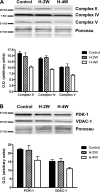Mitochondrial content and distribution changes specific to mouse diaphragm after chronic normobaric hypoxia
- PMID: 20007520
- PMCID: PMC2838662
- DOI: 10.1152/ajpregu.00320.2009
Mitochondrial content and distribution changes specific to mouse diaphragm after chronic normobaric hypoxia
Abstract
Chronic hypoxia reduces aerobic capacity (mitochondrial content) in limb skeletal muscles, and one of the causes seems to be decreased physical activity. Diaphragm and other respiratory muscles, however, may have a different pattern of adaptation as hypoxia increases the work of breathing. Thus, we hypothesized that chronic hypoxia would not reduce mitochondrial content in mouse diaphragm. Adult male C57BL/6J mice were kept in normoxia (Fi(O(2)) = 21%, control) or normobaric hypoxia (Fi(O(2)) = 10%, hypoxia) for 1, 2, and 4 wk. Mice were then killed, and the diaphragm and gastrocnemius muscles collected for analysis. In the diaphragm, cytochrome c oxidase histochemistry showed less intense staining in the hypoxia group. The total content of subunits from the electron transport chain, pyruvate dehydrogenase kinase 1 (PDK1), and voltage-dependent anion channel 1 (VDAC1) was evaluated by Western blot. These proteins decreased by 25-30% after 4 wk of hypoxia (P < 0.05 vs. control for all comparisons), matching a comparable decrease in diaphragmatic mitochondrial volume density (control 33.6 +/- 5.5% vs. hypoxia 26.8 +/- 6.7%, P = 0.013). Mitochondrial volume density or protein content did not change in gastrocnemius after hypoxia. Hypoxia decreased the content of peroxisome proliferator-activated receptor gamma (PPARgamma) and PPARgamma cofactor 1-alpha (PGC-1alpha) in diaphragm but not in gastrocnemius. PGC-1alpha mRNA levels in diaphragm were also reduced with hypoxia. BCL2/adenovirus E1B interacting protein 3 (BNIP-3) mRNA levels were upregulated after 1 and 2 wk of hypoxia in diaphragm and gastrocnemius, respectively; BNIP-3 protein content increased only in the diaphragm after 4 wk of hypoxia. Contrary to our hypothesis, these results show that chronic hypoxia decreases mitochondrial content in mouse diaphragm, despite the increase in workload. A combination of reduced mitochondrial biogenesis and increased mitophagy seems to be responsible for the decrease in mitochondrial content in the mouse diaphragm after hypoxia.
Figures






Similar articles
-
Muscle endurance and mitochondrial function after chronic normobaric hypoxia: contrast of respiratory and limb muscles.Pflugers Arch. 2012 Feb;463(2):327-38. doi: 10.1007/s00424-011-1057-8. Epub 2011 Nov 24. Pflugers Arch. 2012. PMID: 22113781 Free PMC article.
-
Mitochondrial biogenesis and peroxisome proliferator-activated receptor-γ coactivator-1α (PGC-1α) deacetylation by physical activity: intact adipocytokine signaling is required.Diabetes. 2011 Jan;60(1):157-67. doi: 10.2337/db10-0331. Epub 2010 Oct 7. Diabetes. 2011. PMID: 20929977 Free PMC article.
-
The role of PGC-1alpha on mitochondrial function and apoptotic susceptibility in muscle.Am J Physiol Cell Physiol. 2009 Jul;297(1):C217-25. doi: 10.1152/ajpcell.00070.2009. Epub 2009 May 13. Am J Physiol Cell Physiol. 2009. PMID: 19439529
-
PGC-1{alpha} is required for AICAR-induced expression of GLUT4 and mitochondrial proteins in mouse skeletal muscle.Am J Physiol Endocrinol Metab. 2010 Sep;299(3):E456-65. doi: 10.1152/ajpendo.00648.2009. Epub 2010 Jul 13. Am J Physiol Endocrinol Metab. 2010. PMID: 20628026
-
Muscle immobilization and remobilization downregulates PGC-1α signaling and the mitochondrial biogenesis pathway.J Appl Physiol (1985). 2013 Dec;115(11):1618-25. doi: 10.1152/japplphysiol.01354.2012. Epub 2013 Aug 22. J Appl Physiol (1985). 2013. PMID: 23970536
Cited by
-
Increased hypoxia-inducible factor-1α in striated muscle of tumor-bearing mice.Am J Physiol Heart Circ Physiol. 2017 Jun 1;312(6):H1154-H1162. doi: 10.1152/ajpheart.00090.2016. Epub 2017 Mar 24. Am J Physiol Heart Circ Physiol. 2017. PMID: 28341633 Free PMC article.
-
Diaphragm plasticity in aging and disease: therapies for muscle weakness go from strength to strength.J Appl Physiol (1985). 2018 Aug 1;125(2):243-253. doi: 10.1152/japplphysiol.01059.2017. Epub 2018 Apr 19. J Appl Physiol (1985). 2018. PMID: 29672230 Free PMC article. Review.
-
Sphingomyelinase promotes oxidant production and skeletal muscle contractile dysfunction through activation of NADPH oxidase.Front Physiol. 2015 Jan 21;5:530. doi: 10.3389/fphys.2014.00530. eCollection 2014. Front Physiol. 2015. PMID: 25653619 Free PMC article.
-
Lack of ABCG2 Leads to Biventricular Dysfunction and Remodeling in Response to Hypoxia.Front Physiol. 2017 Feb 21;8:98. doi: 10.3389/fphys.2017.00098. eCollection 2017. Front Physiol. 2017. PMID: 28270772 Free PMC article.
-
Diaphragm Muscle Adaptation to Sustained Hypoxia: Lessons from Animal Models with Relevance to High Altitude and Chronic Respiratory Diseases.Front Physiol. 2016 Dec 12;7:623. doi: 10.3389/fphys.2016.00623. eCollection 2016. Front Physiol. 2016. PMID: 28018247 Free PMC article. Review.
References
-
- Banchero N. Cardiovascular responses to chronic hypoxia. Annu Rev Physiol 49: 465–476, 1987 - PubMed
-
- Band M, Joel A, Hernandez A, Avivi A. Hypoxia-induced BNIP3 expression and mitophagy: in vivo comparison of the rat and the hypoxia-tolerant mole rat, Spalax ehrenbergi. FASEB J 23: 2327–2335, 2009 - PubMed
-
- Bigard AX, Brunet A, Guezennec CY, Monod H. Skeletal muscle changes after endurance training at high altitude. J Appl Physiol 71: 2114–2121, 1991 - PubMed
-
- Breen E, Tang K, Olfert M, Knapp A, Wagner P. Skeletal muscle capillarity during hypoxia: VEGF and its activation. High Alt Med Biol 9: 158–166, 2008 - PubMed
Publication types
MeSH terms
Substances
Grants and funding
LinkOut - more resources
Full Text Sources
Miscellaneous

